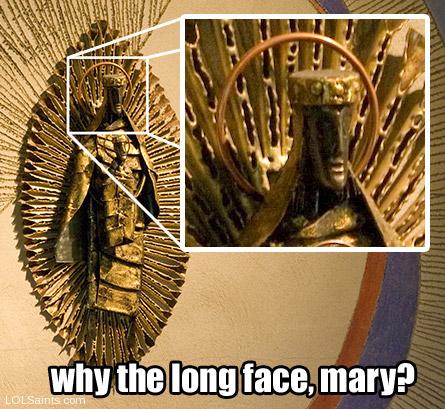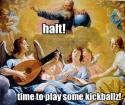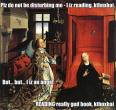Metal Mary

And you, too, Jesus!
Jesus is saying: "Srzly... why do I look like this?"
A passage about the purpose of sacred icons would be quite appropriate for discussion, methinks:
"The artist who creates a work of ark looks to communicate his sentiments, his vision of the world," he explained. "Meanwhile, the painter of icons is called an iconographer and this is a vocation that looks to express through the colors not so much what he feels, his sentiments, but the faith of the Church, of the Christian community he carries inside."
Icons invite to prayer, Nones continued, and "prayer is communion with God; is it not necessarily only to recite formulas but rather to live in communion with his presence and thus certainly in painting an icon, I pray to have a very strong communion with God." [Source]
My main question is: is the above image intended to be iconographic? If so, I think it fails, because I don't think that it truly expresses the 'faith of the Church,' but rather his own artistic style. The artwork on display here is that of a modern art movement—one which seems to have more to say about itself than about the supernatural.
When I view this image, I do not immediately think of the sublime realities behind it. Instead, I think, "What is that supposed to be? Why are those spiky things all over the place? Why does Mary (I'm almost surprised I could recognize her—if this art weren't in a chapel, I'd probably not think it was Catholic at all) I look so weird, and why is the wall all wacky-patterned?"
The great art works of the Church are those that are made with timeless beauty, with an enduring morsel of truth and supernatural glory in them (they need not be gaudy, of course, but have true beauty). The above picture shows a piece of art that might be suitable for someone's private collection, or suitable as an interesting work of art, but I would like to know: do you think art like this belongs inside of sacred worship spaces?
And, if not, do you think that it would be better to have no art at all, if it were left to art like this or none at all?





If art is not transcendent and changes me for the better, and doesn't make me contemplate something higher and better than I am -- I just don't see the point of it.
This example and the ones that are being showcased at Crescat are both demoralizing and debasing. Bad and ugly art is depressing. Bad and ugly religious and liturgical art approaches the demonic.
A paraphrase of Chesterton is apt here:
efo
Good art tells us the truth about its subject; but bad art tells us the truth about its creator.